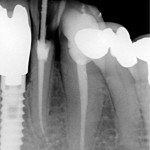
Successful root canal treatment (RoCT) involves the cleaning shaping and filling of the root canal to the apical constriction (AC), the apical portion of the root canal having the narrowest diameter. Estimating the distance between a coronal reference point and the obturation point, known as the working length (WL) is an important aspect of RoCT. Electronic apex locators (EALs) provide one method of ascertaining the WL. The aim of this review was to evaluate the precision of EALs in locating the AC as well as the effects of possible influencing factors.
Methods
Searches were conducted in the Cochrane Central Register of Controlled Trials. Medline, Embase and Scopus databases. Both ex-vivo (measurement on extracted teeth ) and in vivo studies where measurement was performed in vivo and then the teeth were extracted with the endodontic file fixed in the canal and were evaluated histologically were considered. Study selection, data abstraction and quality assessment was carried out independently by two reviewers.
Results
- 10 studies reporting a total of 1105 EAL measurements were included.
- 3 studies were considered to have a low risk of bias and 7 a high risk.
- 4 types of EAL were assessed; Root ZX (J Morita, Tokyo, Japan), Justy II (Hager & Werken GmbH & Co, Duisburg, Germany), Endy 5000 (Loser Co, Leverkusen, Germany), and Endox (Lysis Co, Milan, Italy).
- Root ZX, Justy II, and Endy 5000 were found to be significantly more accurate than Endox in determining the distance between the file tip and the apical constriction (P < .05).
- The mean distance measured by Root ZX and Justy II in the presence of hydrogen peroxide was shorter compared with the mean distance measured by them in the presence of sodium hypochlorite (P < .05).
- The status of the pulp was available for only 194 (17.55%) of all included measurements.
- Pulp status (vital or necrotic) had no significant effect on the precision of the EALs.
Conclusions
The authors concluded:
The precision of electronic WL measurement depends on the device used and the type of irrigation and is not influenced by the status of the pulp tissue (vital or necrotic). Root ZX, Justy II, and Endy 5000 are significantly more precise than Endox. The precision of Root ZX and Justy II improves in the presence of H2O2in comparison with the presence of NaOCl.
Comments
The authors have conducted a broad search and included only those studies with histological evaluation of the actual AC. They have decided to include both ex vivo and in vitro studies but they do not provide information on how many of the studies were in each group. As it is possible that the EALs may perform differently in extracted teeth it would have been helpful to include this information. Overall, the number of available studies is small and the number of EAL measurements undertaken by each machine varies from 412 for the RootZX to 160 for the Endox. This together with the fact that only 2 studies were considered to be at low risk of bias means that additional quality studies could have a significant impact on these findings.
Links
Tsesis I, Blazer T, Ben-Izhack G, Taschieri S, Del Fabbro M, Corbella S, Rosen E. The Precision of Electronic Apex Locators in Working Length Determination: A Systematic Review and Meta-analysis of the Literature. J Endod. 2015 Sep 23. pii: S0099-2399(15)00753-0. doi: 10.1016/j.joen.2015.08.012. [Epub ahead of print] PubMed PMID: 26409810.
Dental Elf – 9th Jun 2014 – Electronic Apex Locators may perform better than radiography alone

Electronic apex locators – precision varies with devices http://t.co/lhB2oTLmNw
Electronic apex locators not influenced by the status of the pulp tissue- suggests review http://t.co/lhB2oTLmNw
Precision of electronic apex locators varies with type of device http://t.co/lhB2oTtLoW
Electronic apex locators influenced by type of irrigation- suggests review http://t.co/lhB2oTLmNw
Don’t miss – Electronic apex locators – precision varies with devices http://t.co/lhB2oTLmNw